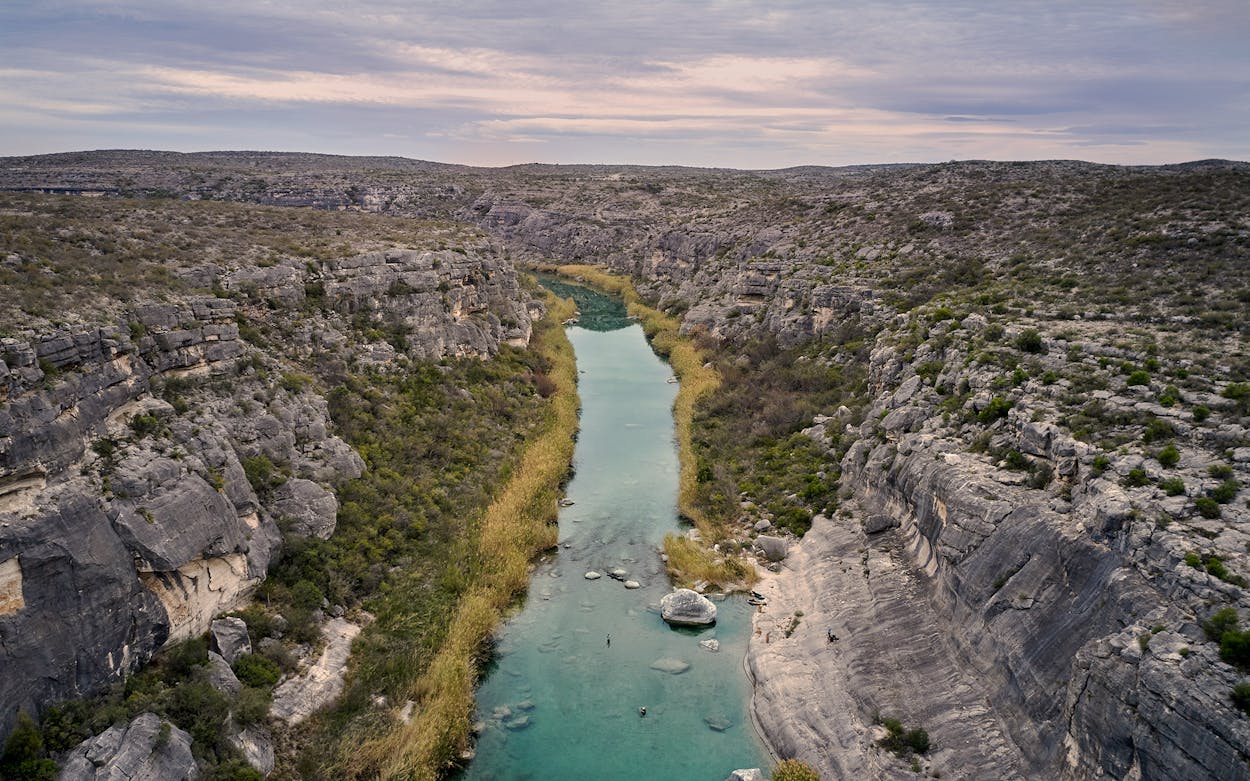The shark attacked before Eric “Oz” Ozolins even finished putting out his baits. For an hour or so, Ozolins had been bobbing in his orange kayak, ferrying chunks of stingray four hundred yards off Padre Island National Seashore. Just as he turned to ride the waves back to the beach to fetch more bait, one of his rigs was hit—hard.
It was a bright December day, and I was watching from a tall fishing platform mounted on the bed of Ozolins’s truck, parked on the shore. It was my job to keep an eye on our lines. Just as I’d begun to reel slack from one ten-foot-long fishing pole, another rod seemed to explode. The Kevlar line jerked with so much force that the body of the truck lurched wildly beneath my feet. As the platform quaked, I reached for a handrail to steady myself, and tried to think. What the hell do I do now?
Even from my elevated perch, I couldn’t see the beast. But there was no doubt about it: this was a big fish. The line jerked again. Then it went still. To my surprise, the fish had gotten away, but not before it left a ragged, jaw-shaped chunk in the bait. I didn’t have time to be disappointed. Before long, another reel was sizzling with another monster on the end. And this one wouldn’t get away.
For weeks I’d been fishing my way across Texas. My assignment: explore the wide, wide world of Texas fishing with the help of some of the state’s best anglers. Along the way, I hoped to reel in some big ones and collect plenty of tales—both the true and tall varieties. Hard work, let me tell you. In truth, until that moment on Padre Island, the only real challenge had been choosing from among the state’s abundant lakes, rivers, and bays. Though Montana, Alaska, and (argh) California are also in the conversation, Texas is arguably the best fishing destination in the country, when you account for the variety of species, the diversity of settings, and the potential for landing a trophy. “An average angler can realistically have a chance to catch a really big fish,” notes Craig Bonds, with the Texas Parks and Wildlife Department. “You can do it in Texas—and not just in a few water bodies.”
Given the state’s generally healthy fisheries, it’s no wonder that Texans spend an estimated annual $2 billion on fishing gear and services. And 1.8 million of us bought a fishing license in 2018, edging out California’s 1.7 million licenses.
The coronavirus era might be a good time to dust off the tackle box. Cities and counties that enacted stay-home orders have typically carved out exceptions for outdoor activities. Some, like Harris and Denton counties, explicitly allow fishing, as long as you maintain social distancing.
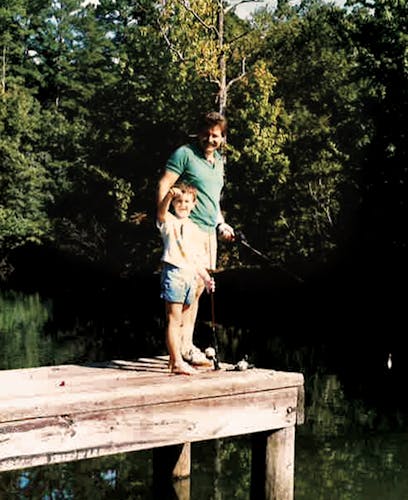
I cast a wider net for my angling adventure. Over the course of three months, ending just as COVID-19 was reaching Texas, I endeavored to experience the best fishing the state has to offer, visiting a slew of places that will still be here when the emergency passes. My adventures took me to the Trinity River, in East Texas, where I helped land an alligator gar, down to the Gulf Coast, where I caught a limit of redfish and speckled trout, and to the dramatic canyonlands of the lower Pecos River, where I went fly-fishing (from a kayak!) for the first time in my life.
When I was little, my dad taught me to cast for bluegills and crappie from the banks of lakes in the Piney Woods. It was a rite of passage that tied us to an older way of life, when a full stringer meant your family wouldn’t go hungry. In my late twenties, I ran trotlines for catfish, which kept me fed when money was tight. But I was far from a skilled angler.
There are two kinds of fishermen, an old saying goes: those who fish for sport, and those who fish for fish. I was in the latter camp. I’d never advanced much beyond plunking a baited hook into the water and waiting.
But all of that was about to change.
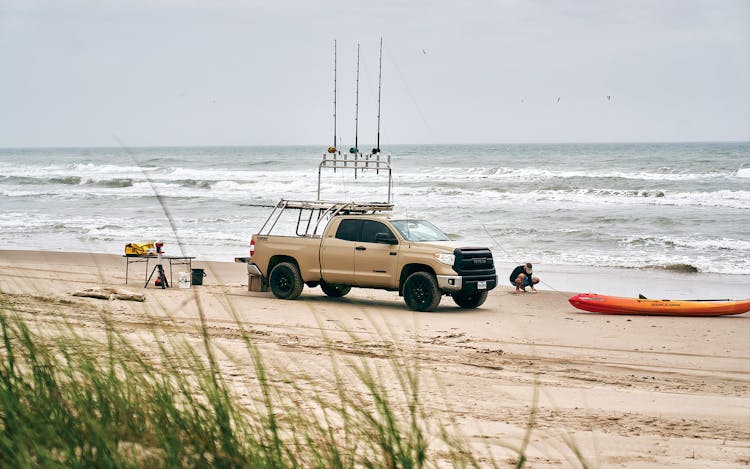
Surf Fishing for Sharks
Location: Padre Island National Seashore
Targets: Blacktip, sandbar, and other shark species
A few hours before my encounter with the shark that got away, Oz Ozolins kept a close eye on the surf as we cruised down Padre Island. With one hand on the wheel, he studied the waves as they broke on shallow sandbars. He was looking for darker-colored water, an indication of deep “guts” between the breakers. These were the cruising lanes for the Gulf of Mexico’s most rapacious predators: the bull shark, the endangered mako, and Ozolins’s personal favorite, the tiger.
“It’s a real mystical fish,” he said of tiger sharks, which can weigh up to 1,400 pounds and can easily measure twelve feet from nose to tail. “When you see them in person, they have this big black eye, big square head, and teeth like serrated triangles. I mean, they’re so cool.”
For 24 hours, we were going to catch as many sharks as possible. From the Malaquite Visitor Center, we raced about sixty miles south, down to the end of the beach, a jumble of rough-hewn granite boulders forming the north jetty of the remote Port Mansfield Channel, a man-made cut dividing North and South Padre Island. “I’ve probably spent more days on this beach in the past twenty years than anybody alive,” said Ozolins, a perma-tanned blond forty-year-old and one of the only full-time shark guides at Padre. He’s a walking encyclopedia of shark facts and lore. Sharks, he tells me, are most active in the waters off Padre in spring and fall, but he catches the biggest hammerheads and tigers in late July and August, when they come in to feed on newborn litters of stingray pups. Though we’re fishing in winter, the off-season, he’s still confident that we’ll have tight lines.
The state’s shark harvest is tightly regulated through daily bag limits and size restrictions. Although sharks are the Gulf’s apex predators, they grow very slowly, travel widely through international seas, and are prized on the black market, leaving them particularly vulnerable to poachers, like the pirate fishermen who sneak into state and federal waters from Mexico in swift, narrow boats called lanchas. The tools of their trade include outlawed gill nets, which fish can’t escape, as well as “longlines” barbed with hundreds of hooks. Although reliable data is hard to come by, illegal overharvesting is thought to have significantly reduced the number of sharks in Texas waters.

Unlike poachers, Ozolins told me, he releases almost all of the sharks he and his clients haul in, tagging the larger ones below their dorsal fins so researchers can track them as they swim away, only a little worse for the wear. “If I didn’t release them, but actually brought them in to get weighed,” Ozolins said of several sharks he’s landed over the years, “they would have been the state record.”
After backtracking about thirty miles, we found a remote patch of beach where the Gulf was calm enough to suit Ozolins’s needs. Little yellow wildflowers and beach evening primrose dotted ten-foot-tall dunes at our backs. “If you can drive down here where it’s more desolate,” Ozolins advised, “you have a lot more freedom and space.” Plus, he said, the fishing’s better. After quickly setting up a no-frills base camp, Ozolins hustled the stingray chunks in his kayak out well beyond the breakers. Meanwhile, I kept an eye on our numerous fishing poles. Here and there along the horizon, gulls hovered like white clouds before dive-bombing baitfish chased by schools of fast-swimming bonito.

Soon, using different kinds of bait, we were reeling in juvenile sharks and baitfish left and right. Once the sun set over the dunes, the breeze cooled, and I sat and dug my toes into the sand. Around ten o’clock, a battery-powered alarm connected to one of our bigger rods started blaring: a fishing emergency! I leaped from my chair, hopped on the bumper of Ozolins’s truck, and raced up the ladder as the rod tip bounced in the starlight. The shark fought and tugged against the two-hundred-pound-test line, so I gave it slack, as Ozolins had instructed. Whenever it turned and swam toward shore, I reeled as frantically as I could. Ozolins has caught so many intimidating sharks that he refuses to swim in the water at Padre Island. But as soon as I’d reeled this one into the shallows, Ozolins marched into the waves, and helped me haul the shark onto the beach. In the glow of our headlamps, we saw a blacktip shark more than five feet long—stunning for me, if less exciting for Oz, who regularly catches much larger fish. After a quick photo, Oz dragged the shark by its tail back into the Gulf.
That night, he slept in his truck, and I slept on a tent cot. Back to “work” the next morning, the alarm sounded, and I hopped up the ladder to the platform, where the tip of a rod was jerking wildly. Following Ozolins’s instructions, I kept the line taut but let more line feed when the unseen fish tried to race toward deeper water. Whenever it stopped for a break, I cranked the reel with as much speed as I could muster. It felt like I’d been turning the handle forever, until a glimpse of the shark’s dorsal fin slicing through the water gave me a jolt of renewed energy. Once the fish had reached the shallows, Ozolins again marched into the water, put the line under his armpit, and pulled our catch onto shore. There before us lay a six-foot-long sandbar shark.
By then, we’d attracted a few gawkers who noticed me fishing on the platform and parked their trucks to watch the spectacle. One couple got out to take pictures. Ozolins quickly tagged the shark so researchers from nearby Texas A&M–Corpus Christi could track its movements via satellite. I ran my hand along its brown-gray body before we dragged it back to the ocean; the wet skin was rough as sandpaper. I’d been to Padre Island plenty of times, but my adventures mostly involved swimming and roasting oysters over a campfire, never anything like this, from the lull one moment of wind-driven waves crashing on the beach to the sudden thrill of that first strike—it could be anything!—and the spine-tingling sensation of a close encounter with a fish that, under different circumstances, could tear me to pieces. It was certainly nothing like the fishing that drives most anglers wild in my native East Texas, where the largemouth bass is king.

Bassin’ With a Legend
Location: The Inn at BK Ranch, near Palestine
Target: Largemouth bass
Celebrity fisherman Gary Yamamoto revolutionized the sport of bass angling. Now he had another tough assignment: fix the flaws in my fishing game. The impromptu lesson came one afternoon when Yamamoto saw my clumsy casts into a pond at the five-hundred-acre ranch he owns with his wife, Beverly, in the gentle hills between Athens and Palestine. “Cast to the base of those trees,” said Yamamoto, nodding toward a leafless copse in the middle of the water. He suspected a largie was waiting there. I followed his advice, or at least I tried to.
My lure, a “Texas-rigged” wildly popular soft plastic worm called the Senko, missed the target entirely. It sailed into the trees, where it snagged on a thicket of bare limbs. The Senko, manufactured by Gary Yamamoto Custom Baits, may have transformed bass angling over the past couple of decades, but it’s not much good when dangling above the water. Yamamoto shrugged. “That’s where accuracy counts,” he said.
As I wiggled my lure free of the limbs, he wandered along the pond’s edge, effortlessly pitching with a flick of the wrist and promptly reeling in a bass. Two casts later, my own line jerked left and then right. I remembered another word of advice. “You don’t have to set the hook,” Yamamoto had told me. “Just keep the line tight. The bass thinks he’s got something good to eat, so he won’t let go.”
He was right.
A slight and soft-spoken man of 76, Yamamoto grew up in Hawaii, the child of Japanese immigrant farmers, and learned to fish when he was barely four years old. He started competing in bass tournaments in the Southwest in the late seventies and soon began manufacturing artificial grubs injected with salt, a flavor that appeals to predators. From his home in Arizona, Yamamoto watched with growing envy as the competitive bass-fishing circuit exploded in Texas. “I had no sales from Texas to Florida,” he recalled of his bait business. To boost his sales, Yamamoto moved to East Texas in 1996 and began entering tournaments across the South to drum up business.
East Texas is a land of lakes, but it wasn’t always that way. The state constructed most of its grand reservoirs in the decades following a horrific drought in the fifties. Artificial lakes soon inundated narrow rivers and streams where native largemouth and other black bass had adapted over millennia. The conditions where the relatively small fish thrived were suddenly gone. Perhaps they would have eventually adapted to their larger home, but Texas Parks and Wildlife Department staffers didn’t want to wait for nature to run its course. So they decided to super-size the bass.
In 1973 a Parks and Wildlife employee named David Campbell, the so-called “Texas Godfather of Big Bass,” traveled to Florida, where natural lakes had long nurtured a king-size strain of largemouth bass. Campbell brought a number of them back to the state fish hatchery he managed in Tyler and before long was releasing millions of Sunshine State largies into Lone Star lakes. The endeavor paid off big-time. By the early eighties, a state record for big bass that had stood for nearly four decades was broken four times in quick succession. Then, in 1986, an angler caught “Ethel,” a famous 17.67-pound lunker in Lake Fork, east of Dallas. “That fish shattered all previous records, garnered nationwide media coverage, and changed fishing in Texas forever,” wrote Larry Hodge, a Texas Parks and Wildlife Department spokesman, in 2012, when Campbell, who died last December, retired.
Ethel sparked a bass-fishing frenzy across the state. Expensive bass boats rolled off manufacturers’ floors. (I’ve always been partial to the boat builder in my hometown of Kilgore, purely for its name: Skeeter.) Campbell played a key role in instituting the ShareLunker program, in which anglers donate their biggest catches to be paired with pure Florida largemouths, spawning ever-bigger fish. Perhaps even more important were tighter limits on the size of bass an angler could keep, and a shift toward catch-and-release practices, which allow more bass to reach maturity and spawn greater numbers of offspring.
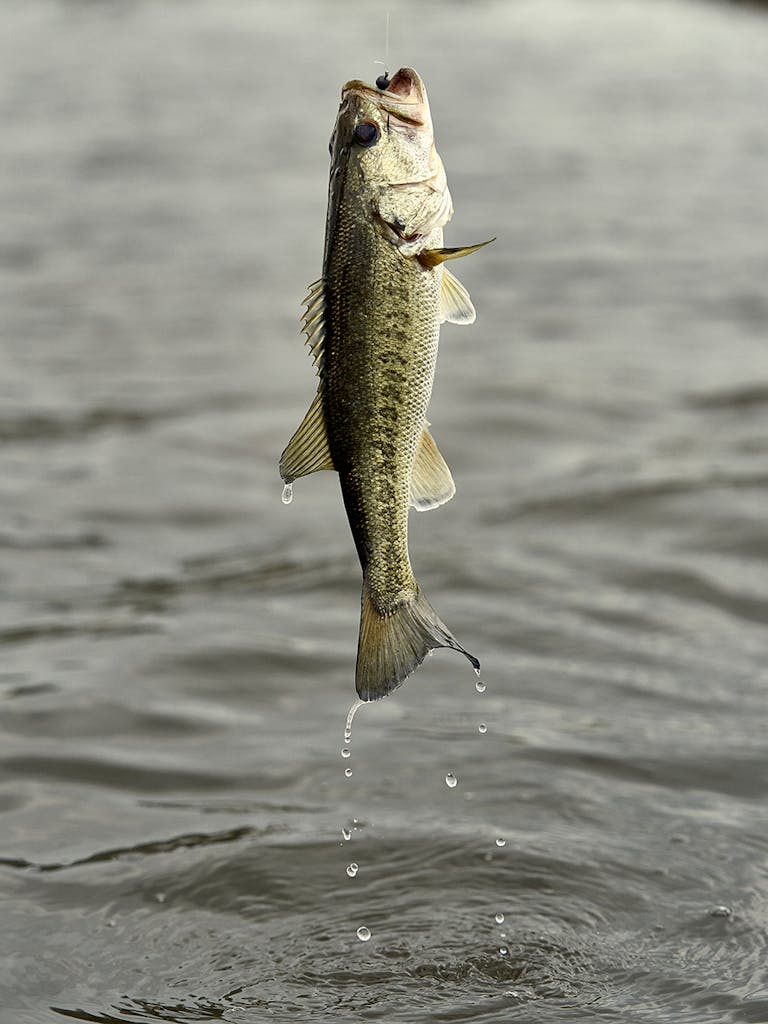
The same year he moved to East Texas, Yamamoto was fishing in a Florida tournament where his fellow anglers were raving about a new lure called the Slug-Go. Shaped like a stick, it made erratic movements that mimicked injured prey when twitched. “The fish loved it,” Yamamoto said. “They’d hit it. You just couldn’t catch the fish.” He thought the Slug-Go was too big, the plastic too hard, for bass to consistently swallow it.
For his own take on this new kind of jerkbait, which he would name Senko (the word can mean “flash” in Japanese), he tried whittling dowel rods to create a wooden prototype, but nothing looked right. Finally, Yamamoto examined the Bic pen he kept in his pocket. Tapered at the bottom, wider at the top, the shape somehow made sense to him. He called the foreman of his manufacturing plant in Arizona, where Yamamoto now employs about 120 people, and told him to buy the same pen and make a lure in that shape.
When Yamamoto tested his invention, it didn’t work right. The stickbait made unnatural movements when jerked through the water. The bass stared at it indifferently. His plant manufactured a limited number of Senkos, but Yamamoto had already moved on to other projects. Then, one of his Texas employees discovered a different use for the Senko. Instead of manually twitching the bait, as intended, they simply let it fall through the water. Something about the bait was driving bass crazy.
“It’s strange, but you throw it out there and let it sit for a minute. When it falls, it wiggles by itself because of the softness and consistency of the plastic with the salt,” Yamamoto explained. “I guess you can say most creatures are lazy. You know, if they find something falling in front of their nose, and it looks edible, they’re going to eat it.”
Any angler who’s perused the fishing section of an outdoors store knows there is a dizzying variety of artificial lures to choose from. But these days, it’s rare to find a serious bass angler who doesn’t keep a Senko in the tackle box. “The Senko has been the key to my business for close to twenty years now,” Yamamoto told me as he pitched and flipped the plastic worm into the pond, jerking largies from the water. “This wouldn’t be a big fish at a tournament,” he said, holding up a bass of perhaps a couple of pounds, with a top fin as spiky as a Mohawk. “But it’s a big fish today.”
We took a leisurely stroll along the grassy banks of Yamamoto’s pond. It was easy to catch the largemouth bass on a Senko lure. But nothing about that relaxing afternoon would prepare me for the really big fish coming next.


Catching “River Monsters”
Location: Trinity River near Lake Livingston
Target: Alligator gar
Of all the celebrities in Texas, the alligator gar is surely the strangest. Its name, of course, is no mystery. With hundreds of savage teeth lining the jaws of its long and narrow snout, the alligator gar looks like some kind of biological mix-up: the horrifying head of a reptile fused onto the body of the second-largest freshwater fish in North America.
But looks can be deceiving. The alligator gar is a gentle giant, insists Captain Kirk Kirkland, who calls himself the world’s best alligator gar guide. Every year, hundreds of thrill-seekers travel from Europe, Asia, and throughout the United States to catch and release gar with Kirkland on his home river, the Trinity, which has become the epicenter for “river monster” tourism in Texas.
“All the stories you hear about them climbing up on the bank and eating the village dogs and the cats and the goats and all that stuff?” Kirkland said one morning as his boat drifted through a tannin-stained cove on the Trinity east of Huntsville. “They will not harm you in this water,” he said. “Now, if you get them in the boat, they’re just trying to get away from you, and they may cut you pretty good. But they’re not trying to hurt you in any way.”
I was fishing that day with Kirkland and a couple of blokes who’d flown in from Australia after seeing him lead an alligator gar expedition on an episode of Animal Planet’s River Monsters, one of dozens of TV shows that have featured Kirkland in the past two decades. The Aussies, Michael Marinovich and Ante Zupan, were both starstruck by our gar guide.
The day’s expedition had begun shortly after sunrise, when we climbed into Kirkland’s boat, less than half a mile downstream from the Lake Livingston dam. Fishing from the boat, an aluminum eighteen-footer, we caught several common carp, an invasive species, for use as bait. Then we motored a couple of miles downriver, cool wind biting our faces, until Kirkland cut the motor and drifted toward the riverbank. Baiting unexpectedly small treble hooks with slices of carp, he cast and then placed four fishing poles in rod holders jammed into the muddy riverbank. The rod holders doubled as alarms: when a gar took the bait, it would trip the line, sending a beep to a device that Kirkland kept with us on the boat.
Often described as “living fossils” because they haven’t changed all that much since dinosaurs roamed the earth, the alligator gar can live for nearly a century—and it never stops growing. Reaching up to ten feet in length, elder gars can weigh more than three hundred pounds. Their oddity goes beyond size and appearance, though. While alligator gars possess gills like any other fish, they also have the unusual ability to gulp air when there’s not enough oxygen in the water. My first encounter with a gar happened on the Sabine River about twelve years ago. It had come up for breath, its diamond-shaped scales catching the sunlight as I tried to steer my boat around it. Reacting too slowly, I thudded over the enormous fish. It was probably unharmed: I later learned that alligator gar are plated in natural armor called ganoin, which is similar to the protective enamel in human teeth.
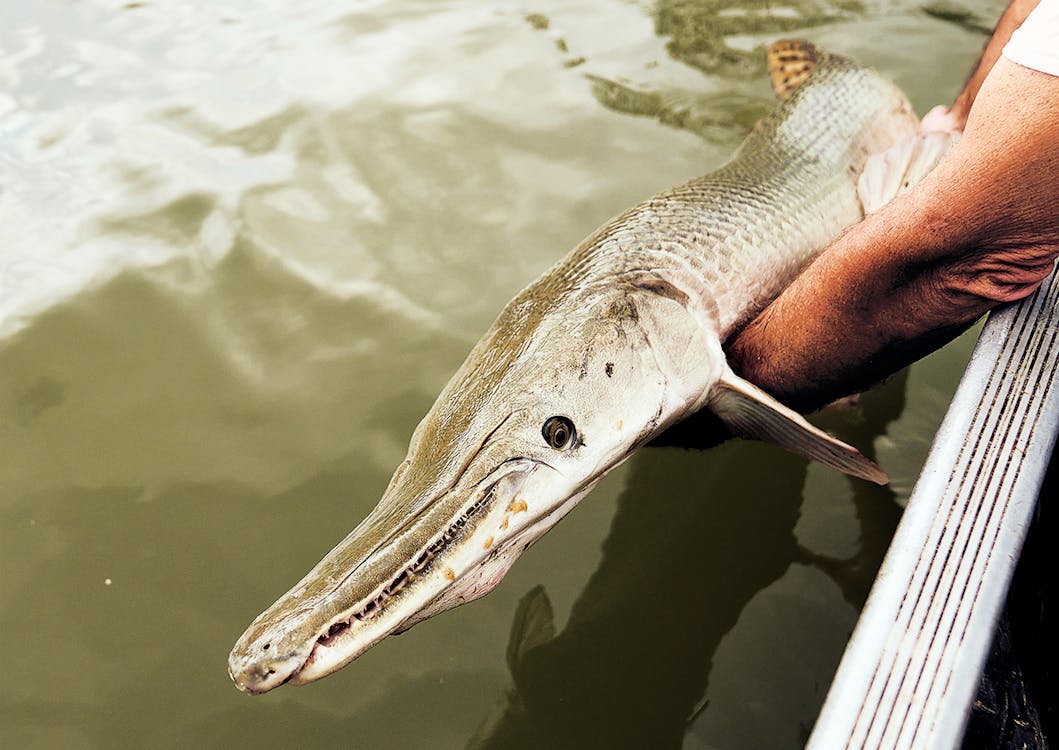
Kirkland and his late father, Byron, taught themselves to catch alligator gar to supply a small chain of fish markets they once owned throughout East Texas. “There was a big market for them,” he said. Gar meat is said to be mild and firm. It’s a fried delicacy in parts of Mexico, and some Cajuns grind the meat into patties called gar balls. (The eggs, however, are toxic.)
In the nineties the Kirklands started guiding European clients to massive gar on the Trinity. Buzz from TV shows and online videos soon drove interest across the globe to a species long dismissed as a trash fish. By 2009, it was in such high demand that the Texas Parks and Wildlife Department limited anglers to just one alligator gar per day. Kirkland said a new round of restrictions implemented last September—most notably, a ban on harvesting any alligator gar four feet or longer from the Trinity without a special permit—has greatly deterred the trophy seekers who’d been killing the river’s biggest alligator gar with compound bows and crossbows.
Under gray skies, Kirkland’s alarm started beeping from a gar’s bite, but he let the fish eat in peace. Because gar have such sharp teeth and bony mouths, Kirkland’s treble hook would simply break off if his clients tried to reel in before the gar swallowed its meal. After several minutes, he motored toward the bank to retrieve the fishing pole, and Marinovich started reeling. The gar fought; then it surfaced. “God Almighty!” Kirkland exclaimed. “That’s a monster fish, isn’t it?”
It was. Marinovich fought it to the side of the boat, where Kirkland slid a noose behind the gar’s pectoral fins the moment it stopped thrashing. With the Aussies’ help, he pulled it into the boat and let its slimy body slide across the floor. “Holy moly!” Marinovich shouted. The trophy fish that had lured him all the way from Australia measured a whopping length of eight feet, two inches, and an estimated 182 pounds. The fish was so heavy, in fact, it took both Aussies to lift the thing for pictures. Giddy with their achievement, they set the prehistoric fish in the shallow water, and then watched it swim away.


Wade Fishing the Coast
Location: Corpus Christi and Aransas Bays, near Port Aransas
Targets: Redfish and speckled trout
Growing up around the freshwater lakes of the Piney Woods, I was a complete stranger to saltwater fishing. The one time my grandparents took me offshore fishing when I was a teenager, I spent the day below deck, curled around a trash can. So, when my epic cross-Texas fishing trip brought me back to the salt, I decided to seek the expertise of Greg Stunz, who has a big advantage over his fishing buddies and tournament competitors—and it’s not just the convenience of docking his boat off the back steps of his canal-front home in Port Aransas.
Stunz, an avid angler and marine biologist, has dedicated his career to the study of the Gulf Coast’s most prized sport fish, including red drum, snapper, and spotted sea trout, more commonly known as speckled trout, or simply specks. He knows more than just about anyone on the Texas coast about the science of recreational saltwater fishing.
Before dawn one morning on Mustang Island, Stunz invited me into his skiff along with his fellow sport fish researchers Quentin Hall and Matt Streich. We wouldn’t be in the craft for long, though. Stunz is a big proponent of getting out of the boat and into the water.
“When you’re wade fishing, you’re right there with the fish in their environment,” said Stunz, the founding director of the Center for Sportfish Science and Conservation, part of Texas A&M–Corpus Christi’s Harte Research Institute for Gulf of Mexico Studies. “You’re more holistically enjoying the experience in nature, you know? Hunting and gathering and fishing are built into our genes.”
As we ventured north from his house, the sun broke pink and mango above a black sliver of land called San José Island, which separates Aransas Bay from the Gulf. He motored his skiff toward Mud Island, which juts into the bay from Saint Jo, as it’s casually called, checking the wind and scanning the horizon until he spotted a few birds and a dolphin. “We prefer to see pelicans diving or dolphins eating, something that tells me there are a lot of fish around here,” he said.
We stopped and waded into the water. The breeze was at our backs, advantageous for casting. Stunz didn’t like the looks of the clear water, though.
“We like a little murk to the water,” he said, because it helps obscure the artificiality of lures and line, which might spook a savvy fish.
I was casting with a beginner’s rig, a soft plastic worm beneath a cork. Stunz was fishing with MirrOlure top-water plugs. Within minutes, he was jerking back his rod and furiously reeling in his first trout of the morning. It was a fighter. And, at about twenty inches long, a keeper.
“Spotted sea trout are known for fighting and crashing the bait with a real hard strike,” he told me. “They’re challenging to catch.” It’s much easier to snag a trout with shrimp or other live bait, Stunz added. “People need to enjoy the experience, so [whichever] method they want to fish, it’s fine,” he said. “But as you become a better fisherman, you’re looking for more and more challenges, and tricking these fish into eating a piece of plastic they think is real is a real accomplishment.”
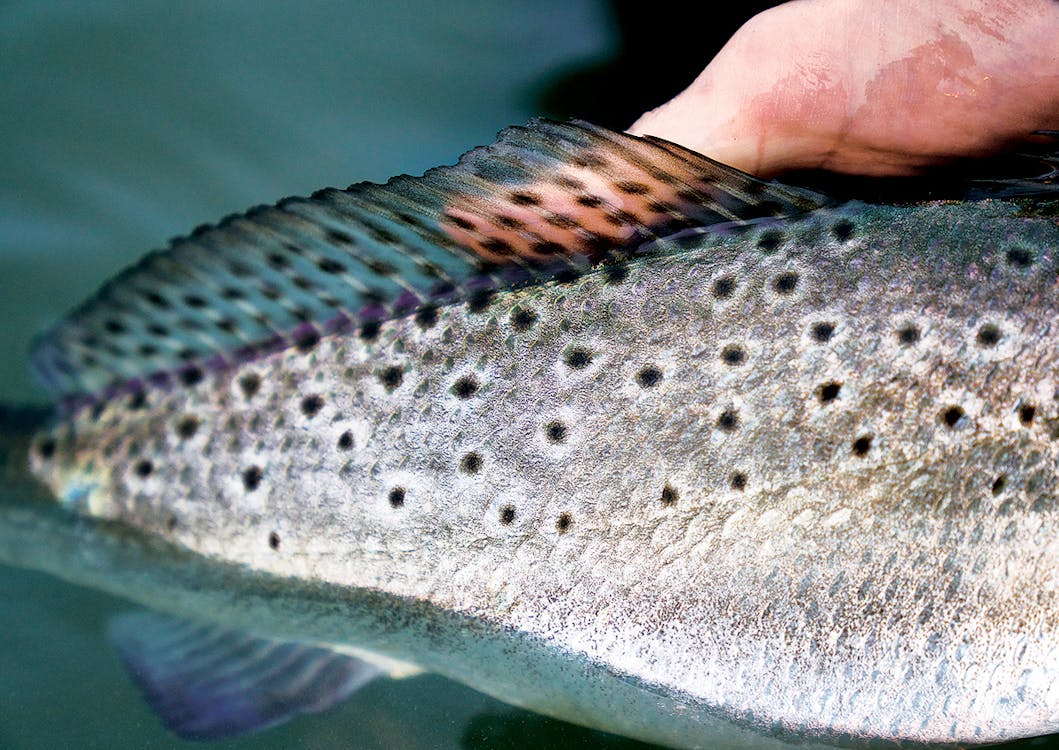
The speck is one of the coast’s most prized sport (and eating) fish, but it is also enigmatic. About a decade ago, Stunz wanted to learn about trout migrations throughout the bays, tidal inlets, and surf along the Texas coast, so he enlisted his team of researchers.
The scientists caught around eighty fish, and kitted them with sound transmitters. The Sportfish Science Center spent the next three years listening in. Their discovery? Trout can travel up as far as seventy miles in a matter of months, but often return to the very spots where they were caught and tagged, for reasons that will require more research to understand. For the angler, perhaps the lesson is that there’s always hope that the one that got away might come back for more.
Back on the bay, Stunz quickly caught three keepers. I’d never seen a speck in real life and was struck by its handsome body with dark spots along its back and tail. Despite its name, Stunz explained, the sea trout is actually a member of the drum family, though its shape is certainly trout-like. The trout were ignoring my soft plastic paddle tail, but Stunz was already closing in on his daily limit of five trout using a topwater lure.
“Topwater is super-advanced saltwater fishing. It’s hard to work ’em,” Stunz said. “But if I get one more blowup, I’ll switch you over.”
When he caught yet another keeper, he paused and tied a MirrOlure onto my line. There are many types of MirrOlures; this one was a topwater twitch bait, so-named because it twitches and makes clicking noises if worked properly. “This is called walking the dog,” Stunz said. “It’s a tricky little technique.” He lightly twitched the tip of his rod to move the bait, then paused and repeated. “See how it’s going back and forth, back and forth? That’s all you’ve got to do, and one will come—whoosh! And if he misses it, you stop and give it one little twitch to see if he’ll come back.”
With a little practice I, too, was catching trout. As the sun climbed toward midmorning, their feeding activity began to diminish, so we backtracked to Port Aransas and an area of Corpus Christi Bay that Stunz requested I generally describe as “the east flats,” so as to not give away his prime spot. There, Stunz anchored his boat. We climbed onto shore, through a tangle of mangroves, and walked about half a mile on a semisoft patch of land, before wading back into a muddy channel between an island and the mainland.
We fanned across the knee- to waist-deep channel, casting as we trudged through the submerged mud. We heard and then saw mating pairs of endangered whooping cranes, the tallest bird in North America, flying over Mustang Island and Corpus Christi Bay. (Yeah, it was that kind of day.) And here, we also found our redfish. Unlike the trout, which thrashed and are known to hop out of the water, redfish charge like bulls. Fittingly, large redfish are often called bull reds.
“Red drum are known for being really strong,” Stunz said. “They are just nose down, hard pull. They either break line or take line, so keep the line sort of tight but give them line before they break. Redfish take a lot of drag.”
By the time we reached the boat, we had our daily limit of both redfish and specks, and Stunz was off the water in time to make a conference call, back to work studying sportfish.
“Catching the fish is the fun part,” he said.

Fly-Fishing West Texas
Location: The Lower Pecos River
Targets: Largemouth bass, channel catfish, spotted gar, common carp
On a gray morning in early spring, with kayaks strapped in tight, I joined a three-vehicle caravan kicking up dust on caliche ranch roads as we made our way toward one of the wildest and most remote rivers in all of Texas—the Pecos.
The entirety of the land along the lower Pecos, from Pandale to Lake Amistad, is in private hands, making short float trips difficult, if not impossible, for most people. In our case, a landowner had given us permission to access the river between the West Texas towns of Comstock and Langtry. Donovan Kypke, the owner of ReelFly Fishing Adventures, in Canyon Lake, two photographers, and I opened a couple of ranch gates and cruised past countless yuccas and the occasional ocotillo. Suddenly, a mile north of the Rio Grande, we arrived at the rim of the lower Pecos River Canyonlands.
The view was stunning. Eons of water coursing through the desolate West Texas desert have carved a deep gorge into the limestone. A dizzying two hundred feet below me was a ribbon of jewel-green water. This is where I was supposed to learn to fly-fish.
We drove down a steep caliche road to reach the river and a small dam, called a weir. The extent of my fly-fishing knowledge was reading (and watching) A River Runs Through It. “Let’s walk out where it’s shallower,” said Kypke, who was showing me a few casting techniques. The brisk water chilled our legs as he demonstrated how to flick the almost-weightless fly through the air. With a little practice, I was feeling pretty suave as my fly—actually, a tiny neon green artificial frog—danced on the line. Kypke also showed me how to use the tension between the water and the line to bend the rod prior to the cast, which created powerful momentum to fling the frog through the air. “Boom!” Kypke said as the fly rocketed off. “Pretty easy, right?”
Kypke changed out my fake-looking frog for a more realistic fly meant to mimic a small crawfish native to streams on the Edwards Plateau. Our party then climbed into our kayaks and paddled upstream through the calm water.
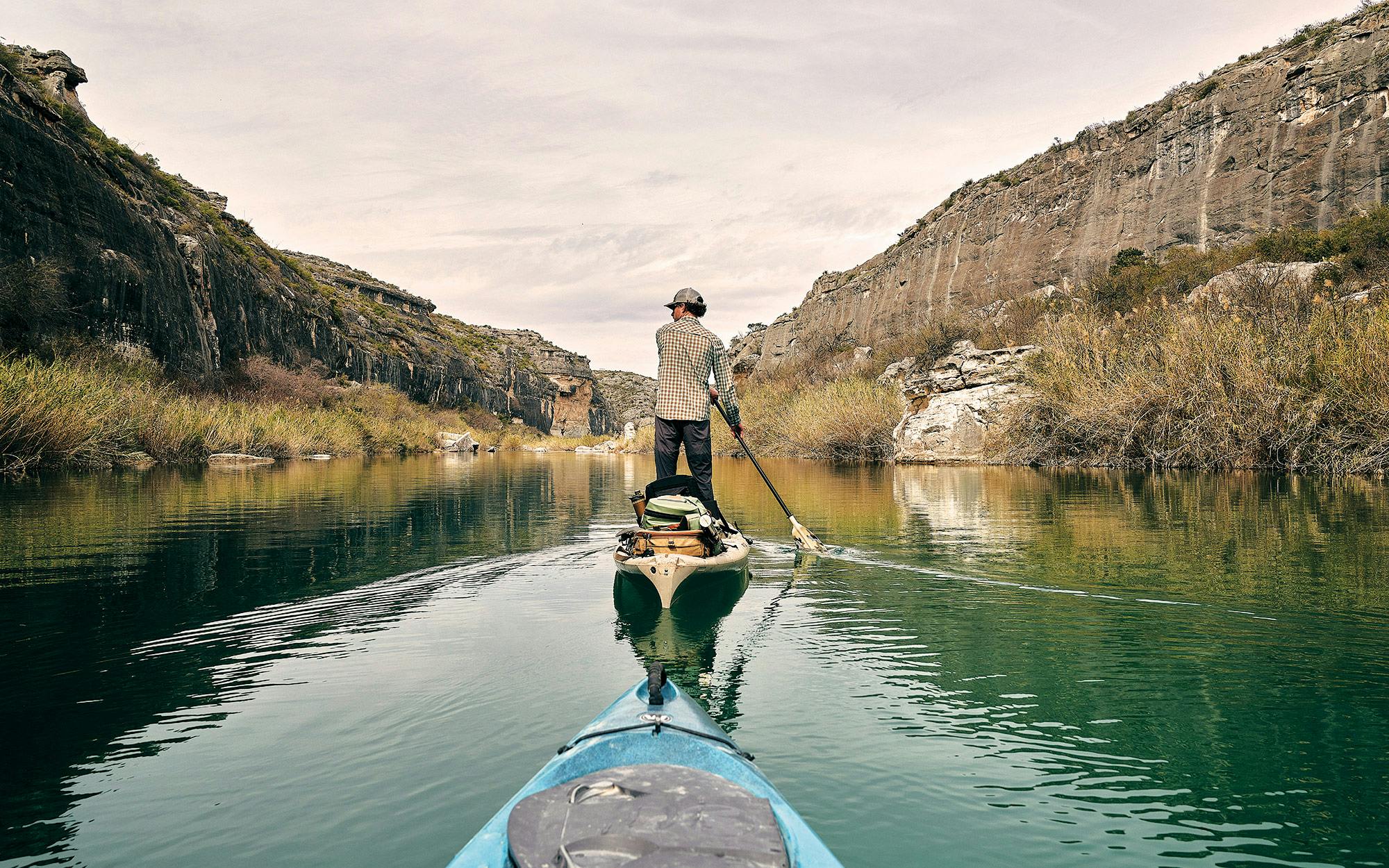
It was a serene scene. The imposing canyon walls towered above us, streaked black and dotted with acacia and other thorny plants clinging to life. An unseen canyon wren serenaded us with its lovely descending song, and the blooms of the cenizo exploded in swaths of purple. Kypke stood on his kayak and fished in the deepening pool, sight-casting for bass and catfish. Big, skittish carp hid in the shadows of cane along the banks.
I hurried to the rushing sounds of shallower water ahead, where I got out and practiced casting toward the spots that Kypke said were more likely to yield prey. “Largemouth bass are an ambush species. They don’t want to hang out in the current all day,” he’d advised. “Look for reeds that give cover, any boulder, deep spot, or break in the current—that’s where you want to be putting that fly.”
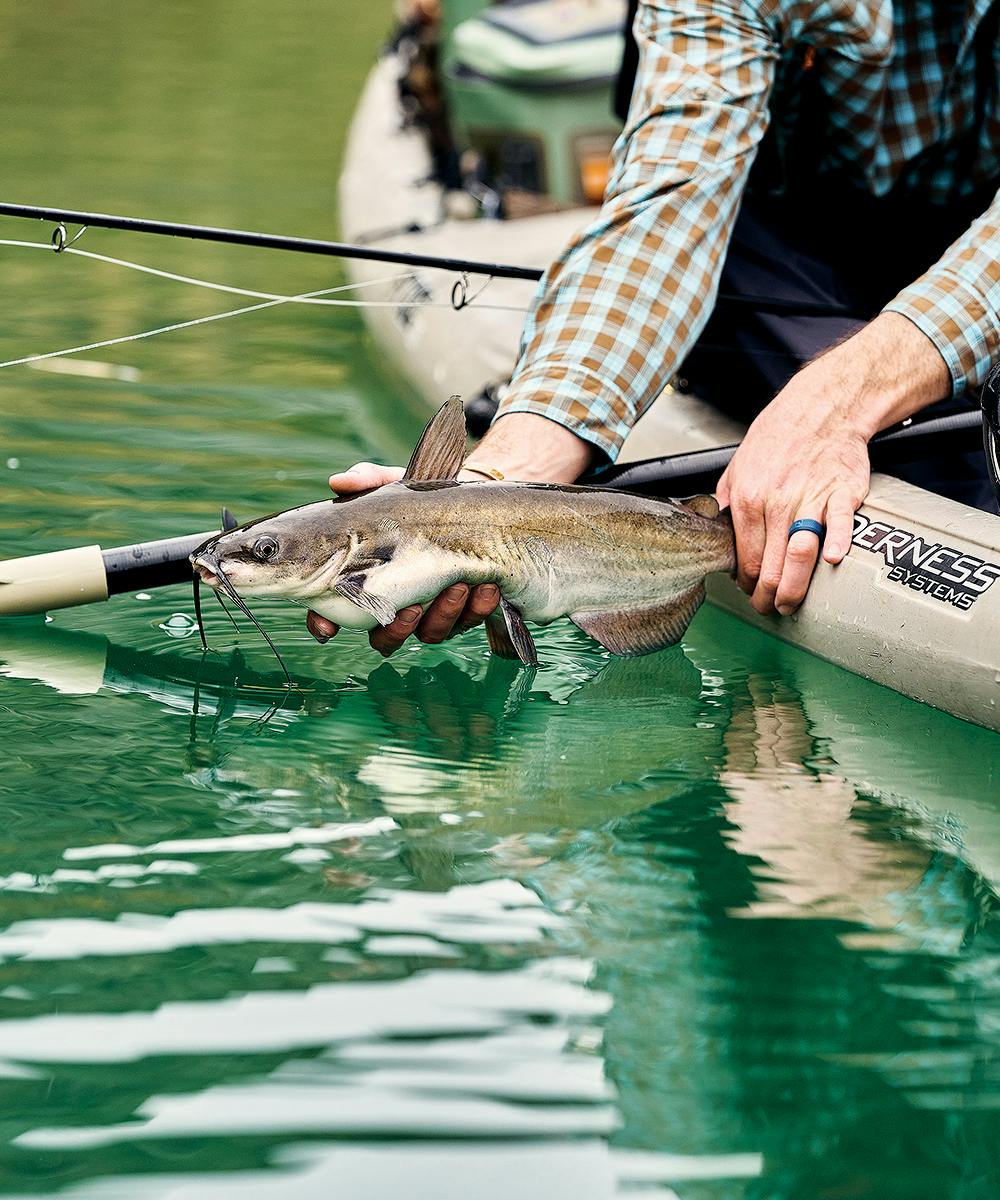
We then dragged our kayaks up the riffles and entered another emerald-green pool. The water was extremely clear and seemed unfathomably deep. Kypke popped to his feet on his kayak again and caught a few more bass and a catfish that would have made great table fare, if we’d brought cooking stuff. I hadn’t known to wear polarized glasses, which would have helped me see the fish in the water, and there was no way I was about to stand on my wobbly kayak. After hours of trying, I still hadn’t caught a fish. I could see them plain enough in the shallower areas: channel catfish and largemouth bass and hulking yellowish carp, but none did more than sniff my fly. What was I doing wrong?
Before long the sun began to fall behind the canyon walls. Instead of turning back, we decided to make camp on a limestone ledge above pleasantly roaring boulder-garden rapids near the mouth of Painted Canyon, where we looked for ancient Native American rock art on the bone-white limestone walls. It felt a little like the ends of the earth—the perfect place to wait out a pandemic. As we dried out in the dark, we passed around sandwiches and a flask of mezcal. Kypke, 35, told us that he’d learned to cast flies in cold mountain streams when he was a child, during family vacations in Colorado. He later applied the same techniques to saltwater fishing when his family moved to Port Aransas. Now he primarily guides on the nearby Devils and Central Texas rivers like the Guadalupe. In the past decade or so, Kypke said, a combination of more affordable gear for beginners and pretty pictures on social media have fueled a boom in Texas fly-fishing.
“Fly-fishing looks so beautiful. That’s always been a big draw,” he said. “A lot of people are used to soaking bait under a cork. Fly-fishing keeps you engaged. You have to be active and involved and thinking and doing, all the time.” It also has therapeutic benefits. “You get so attuned with what you’re trying to accomplish, you kind of cross out everything else.”
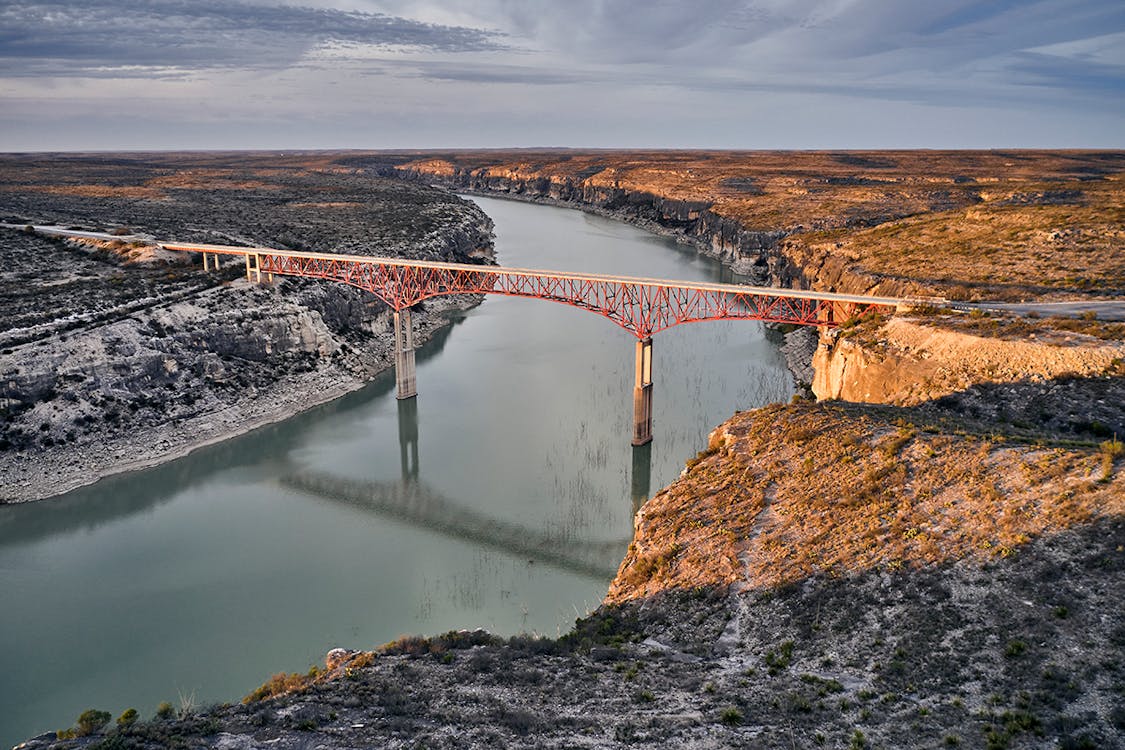
We retreated to our tents as the stars peeked through hazy clouds between the canyon walls. The next morning, we felt a few raindrops. We quickly drank Jetboiled coffee and broke camp, then began the two-mile float back to the weir, where we’d left our cars and a pickup. As we floated, we fished. My kayak had been taking on water. It became even less stable than the day before. When my three companions zipped through the Class II riffles—the kind of mild rapids I’d easily threaded many times in my life—I tried to follow, only to collide into rocks three times, tumbling and repeatedly soaking myself in the chilly water. Eventually I gave up and walked the kayak to the base of the rapids, then tipped it over to drain out the water. The clouds were turning darker and the rain was falling more.
Back at the weir, the photographers took off to beat the storm. But I still hadn’t caught a fish, so Kypke and I waded to the concrete dam and looked below it, where we could see a number of largemouth bass. They seemed to be suspended there in the clear and relatively calm water. Several carp were lurking below the cane along the bank. Kypke had already caught eight bass, the catfish, and a spotted gar, so he dedicated himself to helping me land my first fish on a fly. “Cast behind that rock!” he’d bark, pacing back and forth on the weir. “Now, to your ten o’clock.”
“Good,” he said when I placed a fly in front of a largemouth. “Let it fall. Now strip it!” I pulled the line, desperately trying to interest the bass. Nothing. Then a carp zipped out of the shadows. We’d had no luck with them in two days. I laid the fly in front of its face, and felt the hit. The carp had taken my fly! Instinctively, I jerked the rod back—the way I would have tried to set a hook with my traditional fishing pole—instead of pulling the line. I yanked the fly right out of its mouth.
I looked up through the rain drops and beyond the canyon rim. The sky was black. Holding back my disappointment, I told Kypke that I’d had enough. It was time to leave.

Casting for Trout
Location: Guadalupe River, below Canyon Dam
Target: Rainbow trout
Back home, still hoping to land my first fish on a fly, I sought advice from Aaron Reed, an outdoors writer and conservationist whose impressively detailed guidebook, Fly Fishing Austin & Central Texas, was set to be published this May. To catch that elusive first fish, Reed suggested the rainbow trout in the Guadalupe River. “You’ll catch a fish. It’s guaranteed,” he said. “Well, almost guaranteed.”
One afternoon, a week after my Pecos River trip, I met Reed and his friend Davin Topel, a fly guide and whiskey distiller, near the banks of the Guadalupe. We were a few miles downstream from Canyon Dam, where the Texas Parks and Wildlife Department stocks nonnative rainbow trout each winter, and the water issuing from the dam is just cool enough for the hardiest among the cold-water species to survive a Texas summer.
With all our gear gathered for an afternoon trip, Topel took a moment to initiate me in his prefishing ritual meant to bring prosperity and good luck, which I clearly needed. First, he drizzled honey on the rim of three small cups. Then he filled them with a special liquor called Totem, which he’d crafted during his day job at the Real Ale Brewing Co., in Blanco. It was flavored with nuts, herbs, foraged fruit, malted barley grains, and—to my deep skepticism—the drippings from a wild hog. “You can’t taste the meat,” said Topel, explaining that his recipe had been inspired by mezcal de pechuga, a mezcal historically made with chicken or turkey breast meat for special occasions, in Oaxaca. “The meat gives the spirit roundness and body,” he said. Topel lit the shots on fire, and we drank. It was smooth. The subtle spices came through, but not the hog.
We hit the river. I climbed onto a cooler at the front of Topel’s three-person inflatable raft. On other streams, he explained, trout anglers typically prefer “dry fly-fishing,” which means that the fly floats on the river’s surface. But we would be fishing with flies that sink below the surface and are designed to mimic insect nymphs, which make up the majority of a Guadalupe River trout’s diet.
“Your flies will be dragging, bumping, and rolling around on the bottom,” he said, “but I want your indicator, or bobber, to look like a leaf drifting in the water. If there is any deviation, give it a little pop. Trout have very soft mouths. They’ll come up and nudge it, and if you don’t set it right away, they’ll spit it out.”
As soon as we launched, we saw our first trout: a bizarre-looking palomino. This strain of rainbow trout had been selectively bred for scales the color of a yellow rain slicker. Reed cast toward it, but Topel was eager to move on, paddling us beneath a bridge and past a flotilla of spring-breakers floating in tubes. Both the water and the air were about seventy degrees, but I did not envy the tubers. Warmer weather would bring more people and death to most of the trout, which generally need water temperatures at seventy degrees or below to survive.
At the first set of small riffles, Topel banked the raft and we stepped into the ankle-deep water, casting into the deeper channel and letting our indicators drift as naturally as possible along with the swift water. “The river is like a conveyor belt that brings food to the trout,” Topel explained. “They’re facing upriver, waiting for that cheeseburger to come downriver and get near them. They’ll shoot into the faster current, grab it, and then get back into a holding pattern behind a rock, or a seam in the riverbed, where the current is lessened and they don’t have to use as much energy.”
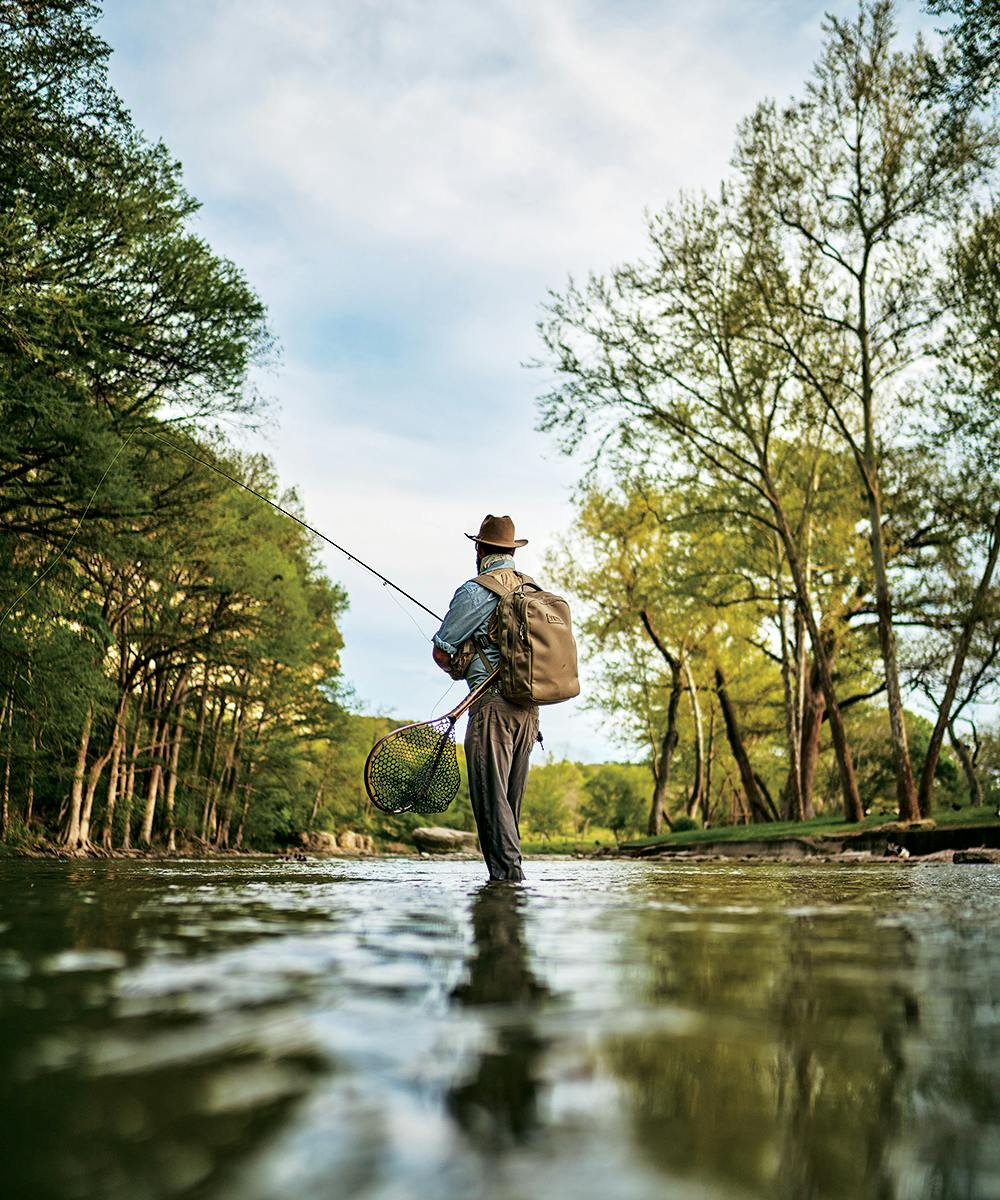
Moving on, we came to the Whitewater Amphitheater, a riverfront music venue where I’d seen Willie Nelson play a few years earlier with Robert Earl Keen, and we again climbed out of the raft and fanned out along the river’s edge. The water was churning through a chute of limestone so narrow I probably could have jumped across it. On Reed and Topel’s instruction, I lightly placed the fly at the top of the chute and let it ride through, a distance of maybe fifteen feet. Something hit. I jerked, but I had only snagged the bottom. I tossed the fly back upriver and felt another. I snapped the rod back. This time, the fly twitched again, against the current. This was no rock.
Keeping the rod bent and line tight—but not too tight—I reeled toward the rocky bank as the fish tried to snap away. Topel shot out his net and lifted a pretty little trout from the water. It was no trophy, but I was thrilled to hold the blue-green body shimmering in my hands. I returned the fish to the Guadalupe, and Topel handed over his net. The wooden handle of the net turned out to be a handmade flask. In a celebratory mood, even if I also felt a little silly, I turned up the net and took a pull from a batch of Topel’s whiskey. Then I caught another fish.
The day was growing late, so we drifted on. Golden light caught the purple blooms of the mountain laurels on the canyon walls. Reed hooked a trout so big that Topel started shouting when it turned and raced toward our raft, only to break free. I almost caught a palomino, but it popped off my line right before Topel could net it from the water. I didn’t mind much. That was fishing.
This article originally appeared in the May 2020 issue of Texas Monthly. Subscribe today.


